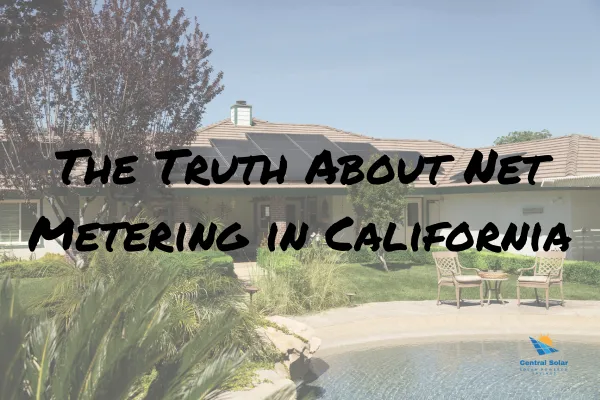
The Truth About Net Metering in California
Let’s clear the air.
Net metering is one of the most misunderstood parts of going solar in California.
Some folks think it’s free electricity for life.
Others believe it’s been killed off completely.
The truth?
Neither extreme is correct.
Like most things, the real story is somewhere in the middle.
And if you’re thinking about installing solar, you need to know exactly how it works—because net metering rules can make a huge difference in your long-term savings.
What Net Metering Really Means
Net metering is simple in concept:
When your solar panels produce more electricity than you use, the extra energy flows back into the power grid.
Your utility company “credits” you for that electricity, and those credits help offset the energy you pull from the grid when the sun isn’t shining.
In other words, it’s like rolling over your unused cell phone minutes—only instead of minutes, it’s kilowatt-hours.
The more credits you earn, the more you save.
What Changed in California
Here’s where things get tricky.
California used to have some of the most generous net metering rules in the country. Under the older program (NEM 1.0 and NEM 2.0), you could essentially trade your excess power for an equal amount of grid power later—almost one-to-one.
But starting in April 2023, the state rolled out NEM 3.0.
Under NEM 3.0, the value of the credits you earn has dropped—sometimes by as much as 75%. Instead of getting full retail value for your extra energy, you now get paid at an “export rate,” which is based on the time of day and the wholesale price of electricity.
That means daytime energy (when the grid is flooded with solar) is worth less, and evening energy (when the grid is straining) is worth more.
Why the Change?
Utilities argued that the old net metering rules put too much cost on customers who didn’t have solar. Lawmakers and regulators claimed they needed a new structure to balance the system and encourage battery storage.
Whatever you think about the politics of it, the change is here—and it’s reshaping the solar industry in California.
The Good News: Solar Still Works
Here’s the truth that doesn’t make the headlines:
Even with NEM 3.0, solar still saves Californians a lot of money—especially if you take the right approach.
You just need to be strategic.
This isn’t the “set it and forget it” solar of the past. It’s about designing your system with the new rules in mind so you maximize savings under the new credit rates.
Batteries: The New Power Player
The biggest shift under NEM 3.0?
Batteries went from “optional upgrade” to “smart investment.”
Here’s why:
Under the new export rates, sending your extra power to the grid during the day pays much less.
But if you store that energy in a battery, you can use it in the evening when electricity is expensive.
This lets you avoid buying peak-rate power from the grid—and that’s where real savings happen.
Think of it like a savings account for your electricity. You’re not just producing power—you’re controlling when you use it.
How to Win Under NEM 3.0
If you’re serious about going solar in California right now, here are the moves that make the difference:
Right-Size Your System – Too big, and you’re selling cheap energy back to the grid. Too small, and you’re buying too much from the utility.
Add Battery Storage – Store extra energy during the day and use it when rates spike at night.
Shift Your Usage – Run high-energy appliances like dishwashers, washers, and dryers during the day to use your own solar power instead of selling it cheap.
Work with a Pro – NEM 3.0 isn’t one-size-fits-all. Your home, habits, and utility rates are unique.
Don’t Let Misinformation Stop You
I’ve talked to too many homeowners who read a scary headline or heard a half-baked rumor and decided to put off going solar.
That’s a mistake.
Electricity prices in California are some of the highest in the nation—and they’re only going up.
Every month you wait is another month you’re overpaying for power.
Yes, the rules have changed. But the game is still winnable if you play it right.
The Bottom Line
Net metering in California isn’t “dead.”
It’s evolved.
And while the rules are different, homeowners who understand them—and work with an installer who does, too—can still slash their bills, protect themselves from rising rates, and increase their energy independence.
Your Move
If you’ve been on the fence, now’s the time to act. The sooner you install, the sooner you start building your own energy future—and the longer you protect yourself from rate hikes.
Let’s talk about your home, your usage, and your savings potential under NEM 3.0. We’ll run the numbers so you can see exactly what’s possible.
